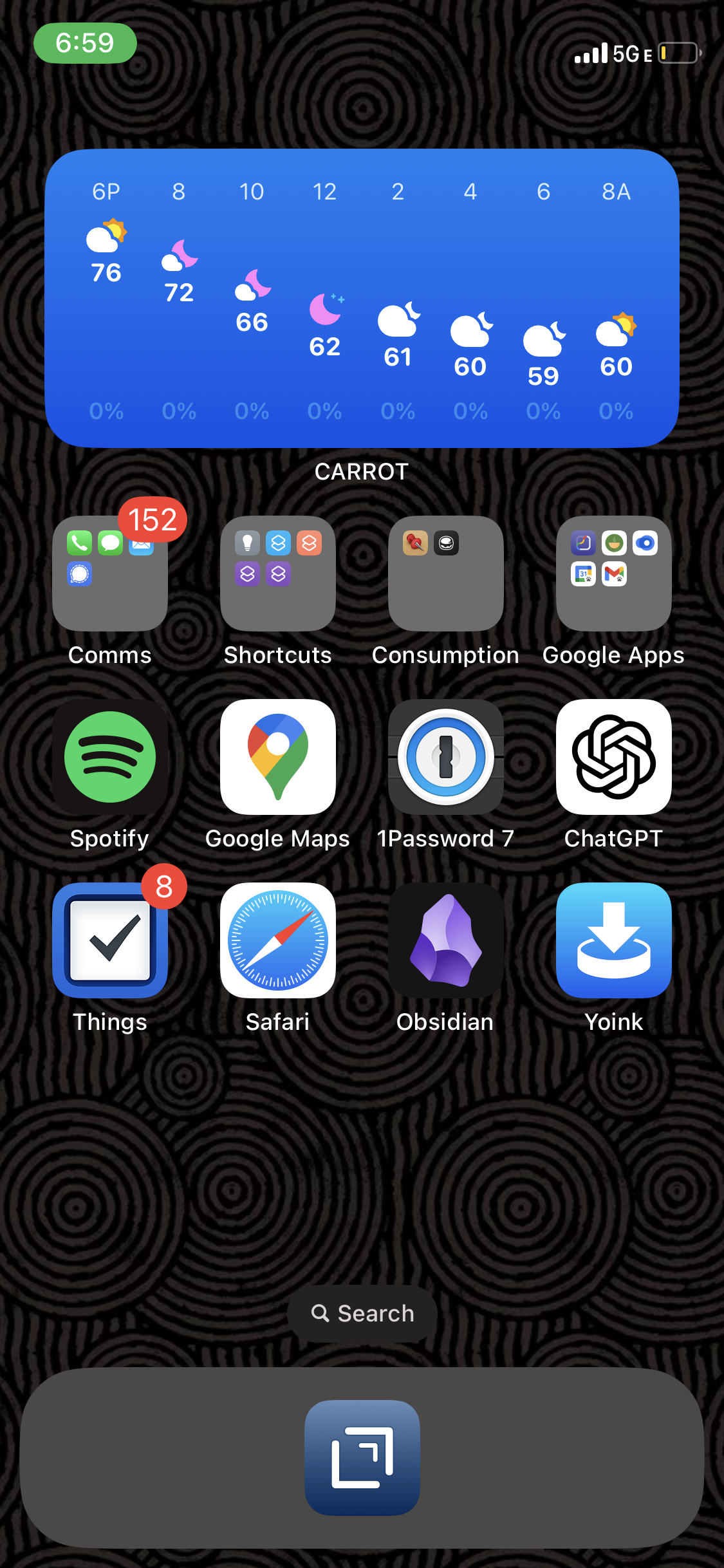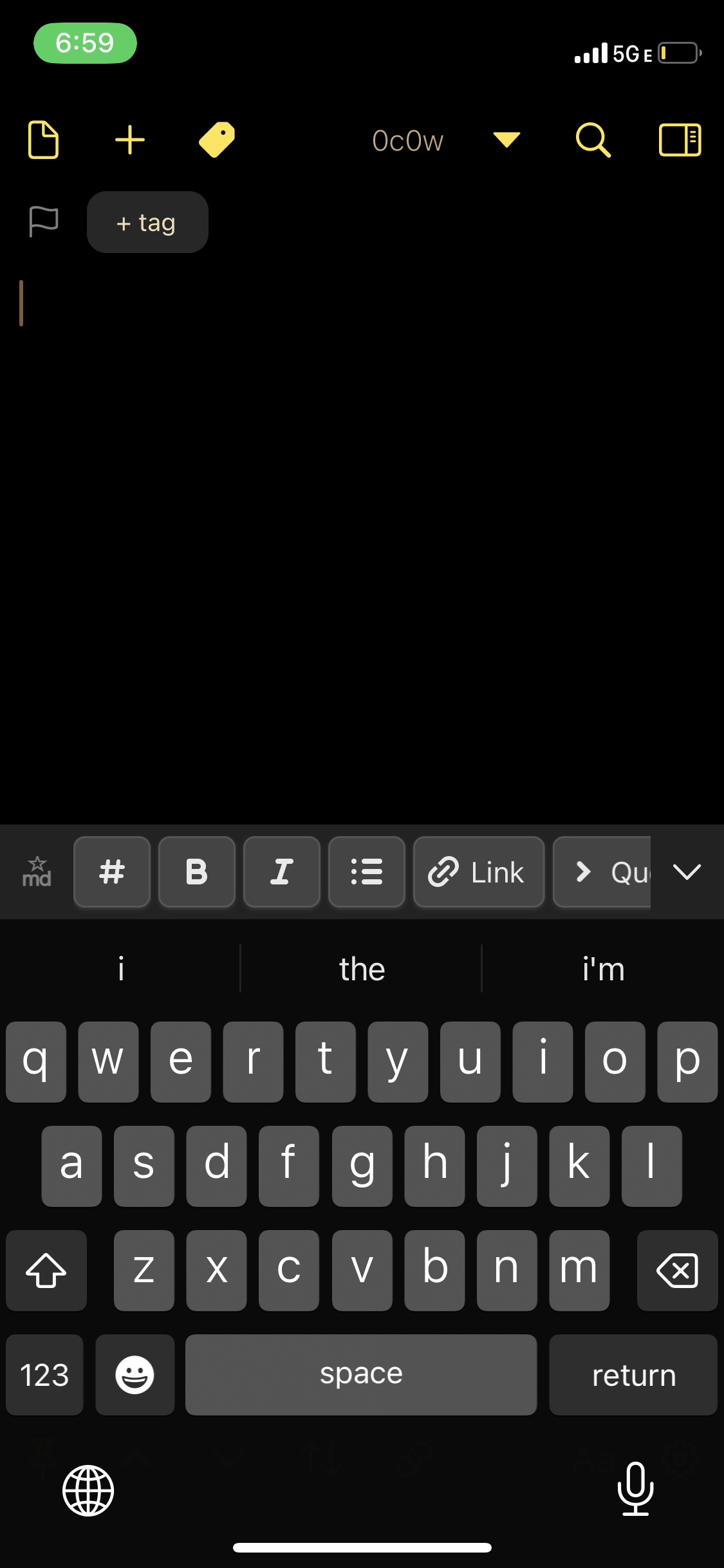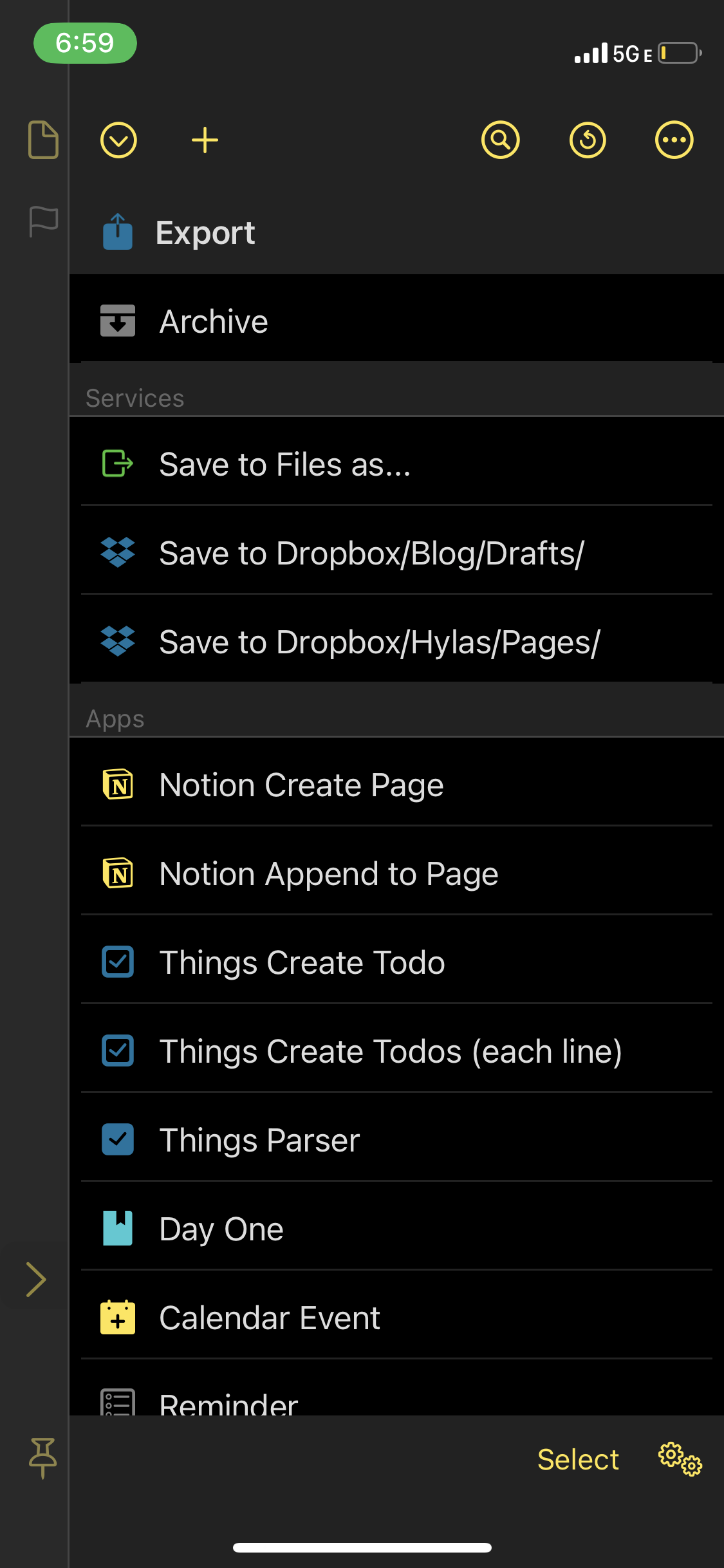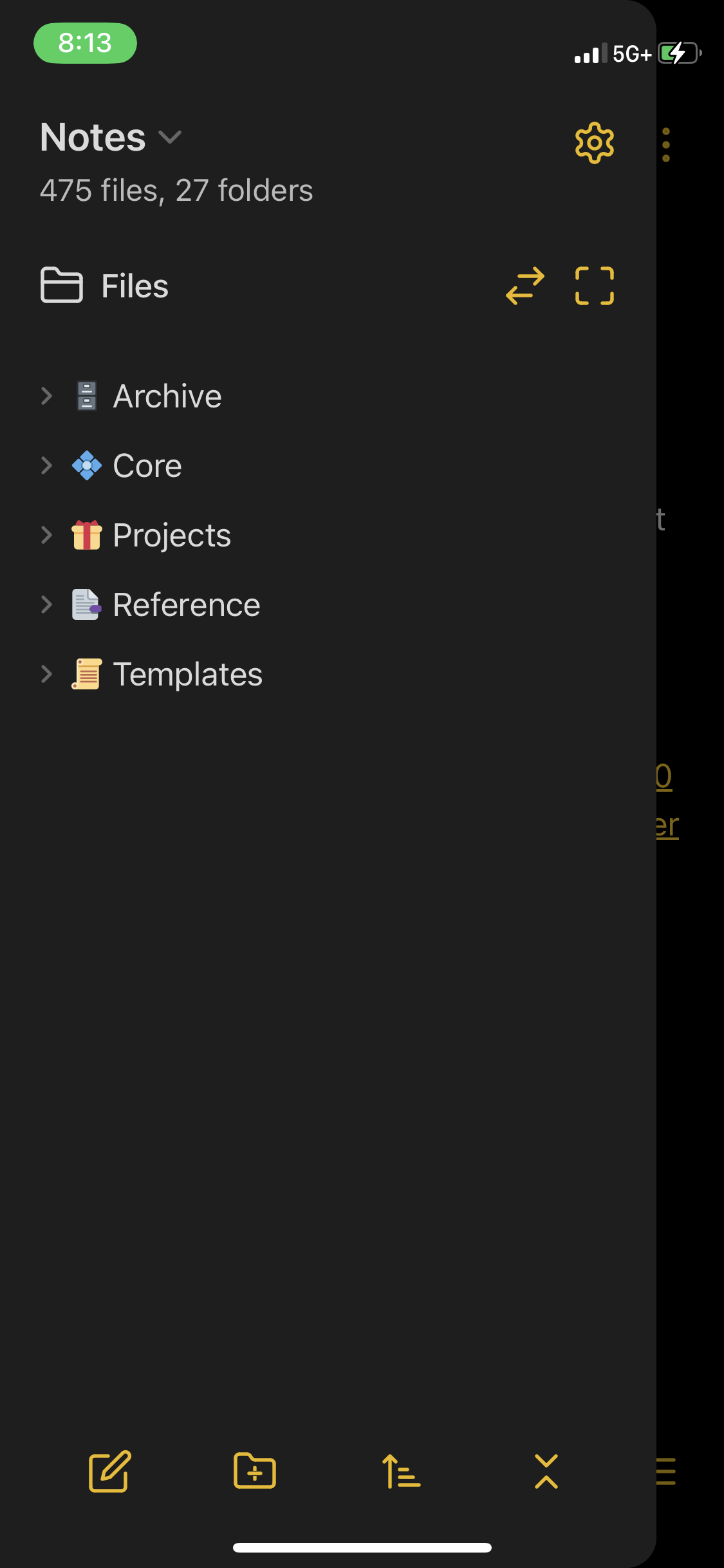Digital Notetaking Stack
So I use a paper notebook. To be more specific, I use a notebook binder with three separate notebooks in it. Each notebook serves a specific purpose. The first one is for tasks and to-dos. The second one is just a scratch pad for absolutely anything under the sun: drawings, thoughts, somebody’s phone number, anything. The last one is a very regimented journal where I reflect on personal experiences.
Sure, I could just use a single notebook for all of these purposes. Hell, I could use a stack of printer paper for all these purposes; but it would be clunky, it would be difficult, and I wouldn’t really want to use it because it wouldn’t be very satisfying.
So, I’ve developed a system that works for taking paper notes. It’s custom tailored to my goals and how my brain works. And as a cherry on top, I picked a notebook binder and pen that I really enjoy touching and looking at, which makes the whole system just that much better.
Similarly, I use a set of different apps for different purposes when I’m taking notes in my digital world.
Yes, I could probably stick to just using the default notes app on my phone, but it would be clunky, there would be friction, it would not adapt to the way my brain works, and I would end up using it less. Plus it isn’t really that satisfying to look at… but that’s just my opinion.
So instead, after nearly a decade of trial and error, I’ve developed a system and way of working with my notes in my digital world that brings me immense satisfaction and works well with the way my brain works and the way my lifestyle is currently set up.
DISCLAIMERS:
- This is not me trying to convince you to use the apps that I use. This is what works for me, and is very tailored to my brain and life. I’m not here to tell you what to use. But if hearing about my setup gives you ideas, that’s great!
- This is something I will continue to change and improve. It’s been a long evolution to land on this setup. Trial and error was involved, and will continue to be. I think there’s an ebb and flow to changing your setup. If you do it too often, you lose productivity. If you don’t do it enough, your setup may stagnate and fail to match your lifestyle.
- This is a values-based notetaking setup. I believe in owning my own data, having an easily exportable format (markdown), and using tools that are extensible & hackable. For someone who doesn’t share these values, this may seem overbuilt or convoluted or not native enough or something.
- This is not written for the PKM enthusiast community. It’s a basic, balanced setup using tools that are widely known. If you’re a longtime Personal Knowledge Management guru, there won’t be anything new for you here. This is written for the layman who is dissatisfied with their current setup and looking for inspiration.
Anyway, if digital notetaking is something that never really clicked for you, or if you currently have a workflow that you’re not pleased with, this might be a blog article for you. Let me know on Mastodon!
Overview
- Intake / Short-term notes
- Long-term notes
- Shared / Published notes
- Collaborative notes
- Closing thoughts
Intake / Short-term notes
One of the most important parts of my setup is my intake app. I hope you’ve never had to experience this feeling:
Your friend names a cool restaurant or book for you to look up later. You hastily pull up your notes app to write it down. But wait. Where should you make the note? Does restaurant fall under your travel folder? Or your food folder? What should you title it? Do you need to make a new folder? While you’re fiddling with your app your friend has already started talking about that other boba place you should explore. Should that go in a whole other note? Oh god.
I feel like a lot of people give up after going through this a couple times and their notes app just ends up being a hodge-podge of unorganized, random shit that they dread looking back at later.
This is exactly why I use an intake app, and my app of choice for this incredibly important role is, of course, Drafts.
Drafts is made for this exact purpose. By default, it opens to a blank new note. Whatever you type as the first line is considered the title. And it has this insane concept called Actions that lets you quickly process your notes by moving them elsewhere through deep interactions with your other existing apps.
Let’s look at some pictures:



In the first image, you can see where I keep Drafts. Front and center, only app in my bottom drawer.
Middle image, you have the first thing you see when the app opens: a blank note to write that restaurant / song / boba place.
Last image, you have the actions pane.
The actions in this pane are customized to my workflow. You are able to configure multiple pages, but I’m content with just one for now.
Drafting a text to your mom? Send it as a text message after you’ve perfected it. Shopping list? Export straight into wherever you keep that (for me it’s Things). Deep thought that’s perhaps a little too deep? File it away in Day One where it will never see the light of day.
Basic tagging, shortcuts integration, and an archive folder really tie everything together. Process a ton of drafts at once by selecting them in the app and then doing a batch operation.
Drafts comes with a pretty comprehensive set of actions right out of the box, but the true power here comes from tapping into the Drafts Directory: a massive repository of actions sourced from the Drafts community (as well as many written by the creator).
Every app you could imagine is in this directory.
And the best part: if your app isn’t in there you can write your own action!
Drafts could honestly take up a whole series of blog posts so I’ll stop there for now. I haven’t even scratched the surface of what it can do, but you really don’t need to dive very deep to reap the benefits.
Let’s table Drafts for now. It’ll come up later with how it pipes into my other systems.
Long-term notes
So you may have picked up on the fact that notes don’t stay in Drafts long. They either get exported or archived.
Not every note is worthy of a permanent place in your note-taking kingdom. Embracing this concept was a huge step in cleaning up my digital world and starting to build a meaningful notes database for my life.
As I continued to acclimate to digital notes, I noticed that certain note categories began to make themselves known.

The middle 3 folders are the important ones to note here.
Core
My core folder is where deeply personal stuff goes. Longterm goals, journal entries, guiding principles and personal mantras. I wouldn’t expect you to understand mine, but I’d encourage anyone to explore this category of notes for themselves.
The notes in this folder don’t change much. But I recently started recording a daily voice note diary of my day that I then transcribe and summarize with AI.
I also do yearly, quarterly, monthly, and weekly planning sessions, and the artifacts from these sessions often end up in here.
Projects
Projects is my favorite folder in my long-term notes.
For me, this is a place for all kinds of things. Packing lists + itineraries + other details for an upcoming trip, startup ideas, potential blog posts, plans and details for my numerous hobbies.
Notes in here often originate in Drafts and get quickly exported to my projects folder via Drafts actions.
Projects are usually temporary, and get moved to my archive folder when they’re completed (or when I get bored and move onto the next hobby).
Reference
This is for lists and information that I will want to keep as reference. Quotes, wishlists, movie bucket list, books to read, etc.
I used to maintain a personal wiki of information on different topics. Zettelkasten-esque, my knowledge wiki is currently in need of cleanup and will likely be featured in its own blog post if I continue to work on it.
Other folders
Archive is self-explanatory. Old notes go in here.
Templates is for fill-in-the-blank templates for notes that I take often. Like those yearly/quarterly/etc check-ins and certain types of projects. There’s an Obsidian plugin that has some functionality to take advantage of these, but right now I just duplicate and move markdown files manually as-needed. Nothing fancy.
I find this setup to be just enough. My main folders allow plenty of flexibility within them for me to develop all kinds of systems to match how my brain works.
Apps and stuff
Yes, yes, we’ll talk about the app I use, but that’s much less important than the underlying foundation.
My long-term note-taking system is really just two things:
- A collection of markdown files
- A syncing service that circulates these files between my devices
If you commit to using the first, you can choose whatever you want for the second and migrate between syncing providers at-will with minimal headache. I’m not going to say much more on that, since others have covered it very well (File over App from one of the people responsible for Obsidian).
And as long as you have these two, you can access all of your notes on all of your devices with whatever Markdown tools you’d like. Ultimate freedom, extensibility, and hackability.
That said, I use Obsidian.
My go-to sync tool was Dropbox for a long time, but after committing fully to Obsidian as my default app across Mac / iPad / iPhone I’ve switched over to Obsidian Sync for the E2E encryption, longer note history, and seamless integration with Obsidian.
It basically works like Dropbox used to before the weird Apple OS integration stuff. Obsidian Sync downloads all the files onto your device, so you still can access them with any markdown editor that has access to the filesystem.
Drafts can export to my longterm notes via both the OS filesystem and Obsidian app urls. Same for Shortcuts, which I’ll get to later.
Obsidian also plays nicely with iCloud, and supports Dropbox / Google Drive / S3 through its community plugins. I have it connected to my Dropbox for publishing / sharing notes, which I’ll get into in a bit.
My main reasons for using Obsidian are:
- It has command palette
- It has quick open
- It’s hackable & has community plugins
Honestly, the specific app here doesn’t really matter as much as the underlying system. I could switch to using Ulysses or 1Writer or Byword or nvAlt or something else entirely if I wanted.
I will say, like Drafts, Obsidian is a product of thoughtful design. You don’t need to dive too deep to reap the benefits. But if you want to be a power user, there’s a LOT it can do. For me, the important thing is that I can open files and do stuff with them easily, and I can hack it to accommodate to pretty much any use case my weird brain comes up with.
Obsidian really knocks it out of the park for me, so I use it almost exclusively right now (for long-term notes).
Published / shared notes
I’m not going to shit on Notion in this post (not much, at least), but one thing I really missed from migrating from it was the ease-of-sharing.
I would put together an itinerary, packing list, cost breakdown, and car-pooling plan for group camping trips in minutes, hit the share button, and fire it off to my group chat of friends with no hiccups.
I had been craving that functionality in my new note-taking system, so I built it. Kind of.
Before we get to that, let’s talk about my workflow for posting blog articles.
Publishing blog posts
Remember how I said I use Dropbox still for sharing / publishing?
I do that with help from a service called Blot.
Blot turns a folder in your Dropbox account into a fully functioning blog.
Their website explains it all, but basically to publish this article I literally just dropped it into a folder in my Dropbox, which I can do without leaving Obsidian.
I wouldn’t say this is anything groundbreaking, but I find it immensely satisfying.
Sharing notes
Okay, back to Notion-esque sharing.
Let’s say I put together a travel itinerary for a camping trip in my Projects folder. It has a list of everyone attending, cost breakdown, directions, packing list, and pictures of the campsite to drum up hype.
It’s all ready to go, but I need to share it out to my friends.
Enter Blot. Same service, different folder. This time, instead of having Blot publish to chrisnotes.io, I have a separate domain I use only for this purpose. I move the note to the shared folder and shoot my friends the link.
The end. No fuss, no need for them to have an account, it’s just published to a non-indexed domain that I use as an external file/note-share.
”But it’s not collaborative!” Yeah, and it’s not meant to be.
Collaborative notes
Okay, so once in a blue moon I have a valid reason to collaborate on a note with someone. It’s incredibly rare, and usually a very niche use-case.
If it’s like a Resume or something, I use Google Drive, because the output artifact is a document.
If it’s for brainstorming or something, Figma.
If it’s project tracking, Notion.
These aren’t really notes anymore. This is a one-off collaboration with a specific outcome in mind, so it doesn’t really fall into the purview of this post.
To be honest, I don’t think my personal notes database is something that would ever require collaboration. My notes are deeply personal, and I like it that way. I can publish if I need to, and there are plenty of collaborative tools that work for other tasks. But I have yet to need real-time collaboration on my actual notes.
My gripe with Notion
Okay fine, quick note on Notion. While it’s a powerful tool that sparks creativity in a very attractive interface, it goes against my core values. You don’t own your data, it’s on their servers the entire time. Offline mode barely works. Exporting is a mess because while they present themselves as Markdown-esque, their stuff is so custom it’s a mess to port to other apps.
You get punished as soon as you try to leave.
Best of luck to anyone entangled in that system. It took some work to get my notes out of Notion, and I will not be going back.
Closing thoughts
You made it to the end!
Personally, after having tried a lot of tools with varying levels of depth and complexity, I find this setup very balanced.
It does just enough. I haven’t gone too deep into any of the tools. It’s still portable. I could still switch stuff around with very little overhead if I wanted to.
Being candid, my sync system is the one thing I am considering changing. I don’t like that Obsidian Sync has no way to run headless, and has no API access for other apps to tap into. If I wanted to change editor, I’d need to switch back to Dropbox. It wouldn’t take much to make the switch: maybe 5 minutes to update the config across all my devices.
But that’s the only thing I’m really not happy with right now. I find this system pretty seamless to work with. It has structure and organization, without being so confined that it limits creativity.
Bonus goodies
If you made it this far, you’re either really into notetaking systems or you’re friends with me. Either way, you might get a kick out of some of the cool functionality that comes from a system like this.
Custom share sheet actions
Any time I’m browsing the web and come across something I want to buy later, I can instantly append it to my Wishlist note using a share sheet action that uses Obsidian’s deep-linking.
I could easily replicate this functionality using the OS filesystem in shortcuts.
Or, if I was using Dropbox, I could do it with Dropbox’s shortcut integrations.
I have a similar shortcut action for prepending selected text to my Quotes note.
If I wanted, I could have an automation that downloads the current weather and top news stories to a daily note for me to review when I start my morning.
With a little scripting, you can really bend any of these tools / files to do whatever you want because of the format.
Anyway, thanks so much for reading this far. I hope you got something from it. And if you have any input, please let me know. I’m not going to pretend I’m any kind of guru, and I love learning new things. If you have suggestions or ideas or feedback, please send them my way on Mastodon!